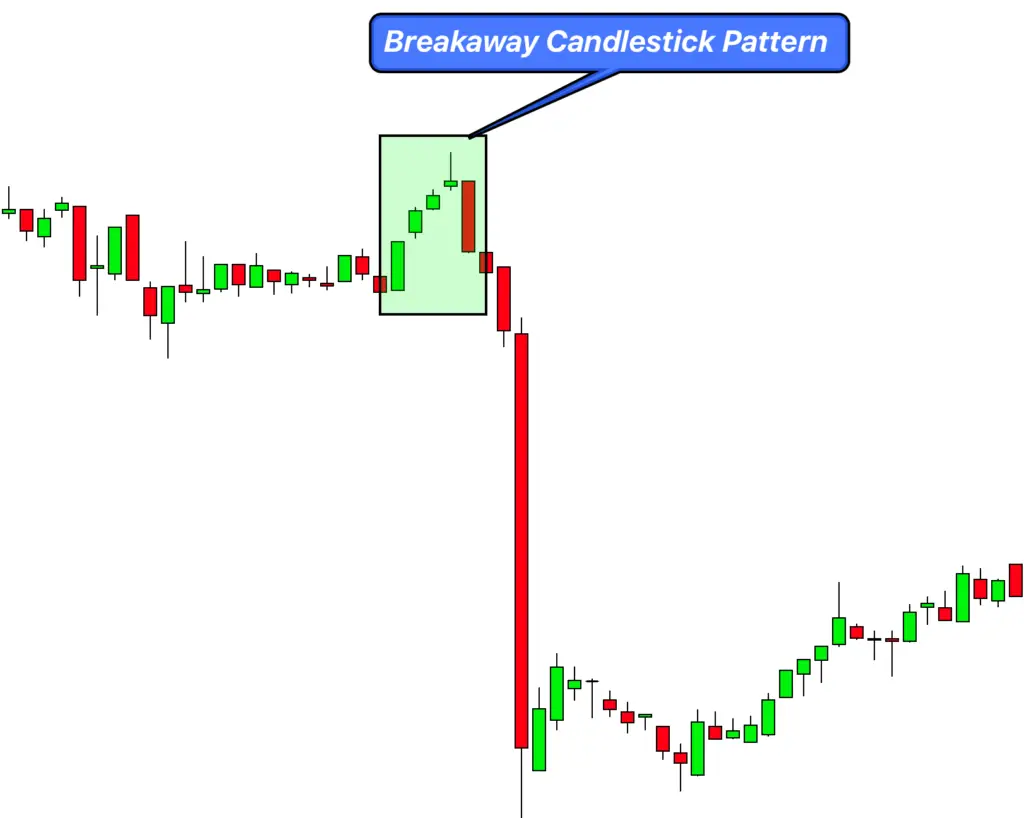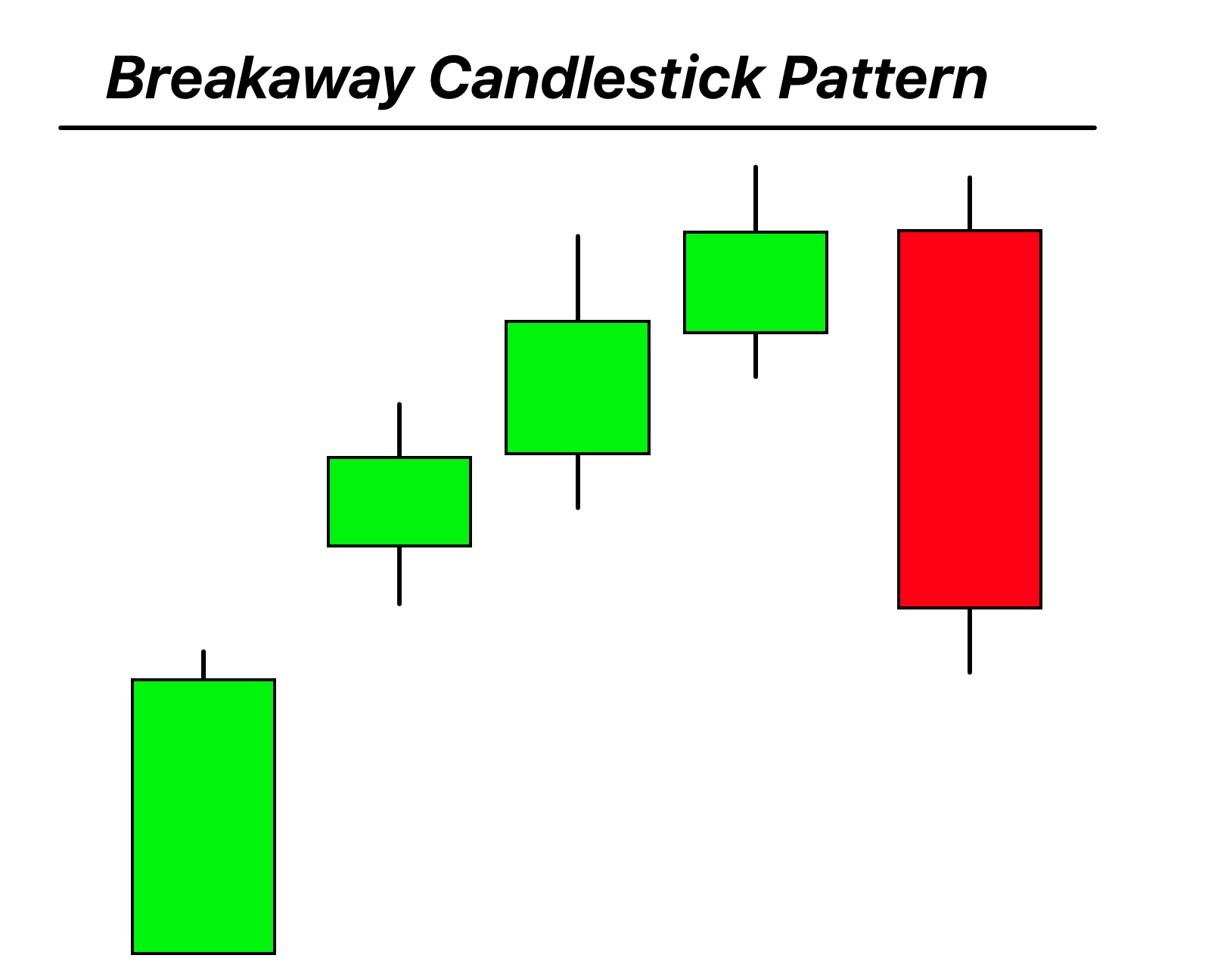Definition
The Breakaway is a five-candle pattern marked by a large gap following a trend, with subsequent candles showing a change in the opposite direction, confirming a potential trend reversal or breakout.
Often seen after a pronounced trend, the Breakaway pattern signals a potent shift in market sentiment, indicating that a new trend, counter to the prior one, might be on the horizon.
How to Identify the Breakaway Candlestick Pattern
- Prior Trend: The Breakaway pattern starts with an established trend in place, either bullish or bearish. This trend sets the stage for the breakout or reversal that the pattern indicates.
- First Candle: The first candle will be a large one that’s consistent with the direction of the existing trend. For instance, in a downtrend, this would be a large bearish (red or black) candle.
- Gap Creation: The second candle will gap away from the first candle. In a bullish Breakaway, this would be a gap down, and in a bearish Breakaway, it would be a gap up. This gap signifies a strong shift in sentiment.
- Subsequent Candles: Candles three, four, and five will be in the direction opposite to the prevailing trend. They start moving towards filling the gap but don’t necessarily close it entirely. These candles confirm the change in sentiment and the potential reversal or breakout.
- Reducing Momentum: As the candles progress from the second to the fifth, they typically show decreasing size and momentum. This slowing down signifies that the initial surge (post the gap) is starting to settle, and the new trend is taking root.
- Volume Insight: Ideally, the pattern should be accompanied by increasing volume on the first and second candles, followed by decreasing volume on the subsequent candles. This volume profile further validates the Breakaway’s significance.

By recognizing these distinct characteristics, traders can confidently spot the Breakaway pattern, which can act as a precursor to a potential trend shift or a strong continuation in the market.
Significance
1. Trend Transition Signal: The Breakaway pattern primarily signifies a possible transition in the market trend. Starting with a solid representation of the prevailing trend (the first candle), the sudden gap and ensuing candles in the opposite direction highlight a dramatic shift in market sentiment. This shift can be a powerful indicator for traders, suggesting that the old trend might be losing steam and a new one could be emerging.
2. Psychological Underpinnings: The gap created on the second day is a result of sudden and strong trading activity, often influenced by news or significant global events. This abrupt change paints a vivid picture of the underlying market psychology. The following candles, moving against the initial trend, further solidify the notion that traders are reassessing their positions, leading to a potential trend reversal or continuation.
3. Risk Management Advantage: For traders, the Breakaway pattern provides clear areas for setting stop-loss and take-profit levels, given its well-defined structure. This clarity can be immensely beneficial for risk management, enabling traders to define potential entry and exit points with greater confidence.
4. Volume Confirmation: When accompanied by notable volume changes, the Breakaway pattern’s reliability increases. A surge in volume during the formation of the gap, followed by diminishing volume on the subsequent candles, serves as a robust confirmation of the pattern.
Behind the Breakaway: Big Traders’ Activity
When the Breakaway pattern emerges on a chart, it often reveals the footprints of significant institutional or “big” traders, and understanding this activity is pivotal for retail traders.
1. Initiation of the Shift: The first candle and the subsequent gap, especially when supported by a spike in volume, can suggest substantial position adjustments by institutional traders. This might be due to new information, a change in macroeconomic conditions, or a strategic decision based on their analysis. The presence of the gap is a telltale sign of urgent entry or exit maneuvers by these market movers, which drives prices aggressively in one direction.
2. Retail Reaction: Post the gap, as the next three candles form, it’s often the broader market, including retail traders, reacting to this initial jolt. They might be closing their old positions, following the lead of institutional players, or trying to capitalize on the anticipated new trend. This reaction often slows, as seen in the diminishing size and momentum of these candles, indicating the initial frenzy settling down.
3. Consolidation or Continuation: By the time the Breakaway pattern completes, the big traders have typically established their new positions. They might continue to build on these if the new trend aligns with their analysis or sit back and let the market digest the sudden shift. This phase can be seen as a tug-of-war between participants who believe in the new direction and those still anchored to the previous trend.
4. Seeking Confirmations: It’s crucial for retail traders to recognize that while big traders have more resources and information, they aren’t infallible. Hence, always seek additional confirmations like volume analysis, key support/resistance levels, or other technical indicators. This layered analysis offers insight into the strength of the sentiment shift and the likelihood of it sustaining.
Confirmation Tools for High Probability Trades
| Confirmation Tool | Description |
|---|---|
| Key Support/Resistance Levels | If the Breakaway pattern forms near significant support (in a downtrend) or resistance (in an uptrend) levels, it reinforces the likelihood of the pattern’s validity. Breaking these key levels can bolster the strength of the new trend. |
| High Volume | A surge in volume during the initial gap followed by decreasing volume on the subsequent candles confirms the pattern. Volume acts as a testament to the strength of the sentiment shift. |
| Break of Low/High Post Pattern | If, after the formation of the pattern, price breaks the low (in a bullish Breakaway) or high (in a bearish Breakaway), it provides an additional confirmation of trend continuation. |
| Momentum Indicators | Tools like the MACD or RSI can offer insights into the momentum of the new trend. Bullish or bearish divergences, or crossovers in these indicators, can further validate the Breakaway pattern’s implications. |
Optimal Conditions for Trading the Breakaway Pattern
Best Timeframe: The Breakaway pattern can materialize across various timeframes, but it’s most impactful on daily and weekly charts. On these longer timeframes, the pattern captures broader market sentiment, and its implications tend to be more lasting.
Trading Session: While the Breakaway pattern can form in any trading session, its significance is heightened when spotted during the primary trading hours of the respective market (e.g., the first few hours of the NYSE for stocks). This is when trading volume and institutional activity are typically at their peak, leading to more pronounced and reliable patterns.
Winning Ratio: The Breakaway pattern might offer a winning ratio of approximately 60-70%, especially when formed on higher timeframes.
Trading the Breakaway Pattern with Confluence
1. Entry Point: Your ideal entry point should be after the formation of the fifth candle of the Breakaway pattern, especially when the price action supports the anticipated trend shift. However, to add confluence, wait for at least one or two of the confirmation tools (e.g., break of key support/resistance levels, momentum indicator signals) to align with the pattern before entering.
2. Stop Loss: Set your stop loss just beyond the high (for a bearish Breakaway) or low (for a bullish Breakaway) of the pattern. This ensures that if the pattern fails and the price moves against the anticipated trend, your losses are minimized.
3. Take Profit: Your initial take profit level can be set at a significant support or resistance level that lies ahead. However, to maximize profits, consider using a trailing stop or look for other technical indicators or chart patterns that suggest potential reversal points as the new trend unfolds.
Conclusion
The Breakaway pattern is a compelling visual representation of a sharp sentiment shift in the market. By adding layers of confluence and coupling it with sound risk management, traders can tap into its potential for significant trend transitions.


